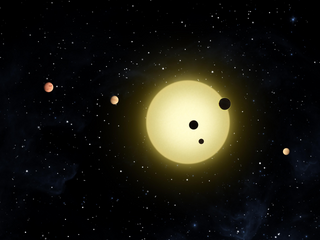Related Research Articles

Chthonian planets are a hypothetical class of celestial objects resulting from the stripping away of a gas giant's hydrogen and helium atmosphere and outer layers, which is called hydrodynamic escape. Such atmospheric stripping is a likely result of proximity to a star. The remaining rocky or metallic core would resemble a terrestrial planet in many respects.

A Super-Earth is a type of exoplanet with a mass higher than Earth's, but substantially below those of the Solar System's ice giants, Uranus and Neptune, which are 14.5 and 17 times Earth's, respectively. The term "super-Earth" refers only to the mass of the planet, and so does not imply anything about the surface conditions or habitability. The alternative term "gas dwarfs" may be more accurate for those at the higher end of the mass scale, although "mini-Neptunes" is a more common term.
This page describes exoplanet orbital and physical parameters.

Kepler-4b, initially known as KOI 7.01, is an extrasolar planet first detected as a transit by the Kepler spacecraft. Its radius and mass are similar to that of Neptune; however, due to its proximity to its host star, it is substantially hotter than any planet in the Solar System. The planet's discovery was announced on January 4, 2010, in Washington, D.C., along with four other planets that were initially detected by the Kepler spacecraft and subsequently confirmed by telescopes at the W.M. Keck Observatory.
Kepler-4 is a sunlike star located about 1610 light-years away in the constellation Draco. It is in the field of view of the Kepler Mission, a NASA operation purposed with finding Earth-like planets. Kepler-4b, a Neptune-sized planet that orbits extremely close to its star, was discovered in its orbit and made public by the Kepler team on January 4, 2010. Kepler-4b was the first discovery by the Kepler satellite, and its confirmation helped to demonstrate the spacecraft's effectiveness.

Kepler-11, also designated as 2MASS J19482762+4154328, is a Sun-like star slightly larger than the Sun in the constellation Cygnus, located some 2,150 light years from Earth. It is located within the field of vision of the Kepler spacecraft, the satellite that NASA's Kepler Mission uses to detect planets that may be transiting their stars. Announced on February 2, 2011, the star system is among the most compact and flattest systems yet discovered. It is the first discovered case of a star system with six transiting planets. All discovered planets are larger than Earth, with the larger ones being about Neptune's size.
Kepler-20d is an exoplanet orbiting Kepler-20. It has a mass and radius similar to Neptune. Despite being the furthest planet from the star, it has an orbit similar to Mercury, meaning that it is a Hot Neptune. Along with the other four planets in the system, Kepler-20d was announced on December 20, 2011.

A Mini-Neptune is a planet less massive than Neptune but resembling Neptune in that it has a thick hydrogen–helium atmosphere, probably with deep layers of ice, rock or liquid oceans.
Kepler-47 is a binary star system in the constellation Cygnus located about 3,420 light-years away from Earth. The stars have three exoplanets, all of which orbit both stars at the same time, making this a circumbinary system. The first two planets announced are designated Kepler-47b, and Kepler-47c, and the third, later discovery is Kepler-47d. Kepler-47 is the first circumbinary multi-planet system discovered by the Kepler mission. The outermost of the planets is a gas giant orbiting within the habitable zone of the stars. Because most stars are binary, the discovery that multi-planet systems can form in such a system has impacted previous theories of planetary formation.

Kepler-62e is a super-Earth exoplanet discovered orbiting within the habitable zone of Kepler-62, the second outermost of five such planets discovered by NASA's Kepler spacecraft. Kepler-62e is located about 990 light-years from Earth in the constellation of Lyra. The exoplanet was found using the transit method, in which the dimming effect that a planet causes as it crosses in front of its star is measured. Kepler-62e may be a terrestrial or ocean-covered planet; it lies in the inner part of its host star's habitable zone.
Kepler-62d is the third innermost and the largest exoplanet discovered orbiting the star Kepler-62, with a size roughly twice the diameter of Earth. It was found using the transit method, in which the dimming that a planet causes as it crosses in front of its star is measured. Its stellar flux is 15 ± 2 times Earth's. Due to its closer orbit to its star, it is a super-Venus or, if it has a volatile composition, a hot Neptune, with an estimated equilibrium temperature of 510 K, too hot to sustain life on its surface.
Kepler-38 is a binary star system in the constellation Lyra. These stars, called Kepler-38A and Kepler-38B have masses of 95% and 25% solar masses respectively. The brighter star is spectral class G while the secondary has spectral class M. They are separated by 0.147 AU, and complete an eccentric orbit around a common center of mass every 18.8 days.

A mega-Earth is a proposed neologism for a massive terrestrial exoplanet that is at least ten times the mass of Earth. Mega-Earths would be substantially more massive than super-Earths. The term "mega-Earth" was coined in 2014, when Kepler-10c was revealed to be a Neptune-mass planet with a density considerably greater than that of Earth, though it has since been determined to be a typical volatile-rich planet weighing just under half that mass.

Kepler-56b (KOI-1241.02) is a hot Neptune—a class of exoplanets—located roughly 3,060 light-years away. It is somewhat larger than Neptune and orbits its parent star Kepler-56 and was discovered in 2013 by the Kepler Space Telescope.
A super-Neptune is a planet that is more massive than the planet Neptune. These planets are generally described as being around 5–7 times as large as Earth with estimated masses of 20–80 MEarth; beyond this they are generally referred to as gas giants. A planet falling within this mass range may also be referred to as a sub-Saturn.
Kepler-1625 is a 14th-magnitude solar-mass star located in the constellation of Cygnus approximately 8,000 light years away. Its mass is within 5% of that of the Sun, but its radius is approximately 70% larger reflecting its more evolved state. A candidate gas giant exoplanet was detected by the Kepler Mission around the star in 2015, which was later validated as a likely real planet to >99% confidence in 2016. In 2018, the Hunt for Exomoons with Kepler project reported that this exoplanet has evidence for a Neptune-sized exomoon around it, based on observations from NASA’s Kepler Mission. Subsequent observations by the larger Hubble Space Telescope provided compounding evidence for a Neptune-sized satellite, with an on-going debate about the reality of this exomoon candidate.
Kepler-1625b is a super-Jupiter exoplanet orbiting the Sun-like star Kepler-1625 about 2,500 parsecs away. The large gas giant is approximately the same radius as Jupiter and orbits its star every 287.4 days. In 2017, hints of a Neptune-sized exomoon in orbit of the planet was found using photometric observations collected by the Kepler Mission. Further evidence for a Neptunian moon was found the following year using the Hubble Space Telescope, where two independent lines of evidence constrained the mass and radius to be Neptune-like. The mass-signature has been independently recovered by two other teams. However, the radius-signature was independently recovered by one of the teams but not the other. The original discovery team later showed that this latter study appears affected by systematic error sources that may influence their findings.
Kepler-277b is the second most massive and third-largest rocky planet ever discovered, with a mass close to that of Saturn. Discovered in 2014 by the Kepler Space Telescope, Kepler-277b is a sub-Neptune sized exoplanet with a very high mass and density for an object of its radius, suggesting a composition made mainly of rock and iron. Along with its sister planet, Kepler-277c, the planet's mass was determined using transit-timing variations (TTVs).
Kepler-277c is the third most massive and second-largest rocky planet ever discovered, with a mass about 64 times that of Earth. Discovered in 2014 by the Kepler Space Telescope, Kepler-277c is a Neptune-sized exoplanet with a very high mass and density for an object of its radius, suggesting a composition made mainly of rock with some amounts of water. Along with its sister planet, Kepler-277b, the planet's mass was determined using transit-timing variations (TTVs).
K2-66b is a confirmed mega-Earth orbiting the subgiant K2-66, about 520 parsecs (1,700 ly) form Earth in the direction of Aquarius. It is an extremely hot and dense planet heavier than Neptune, but with only about half its radius.